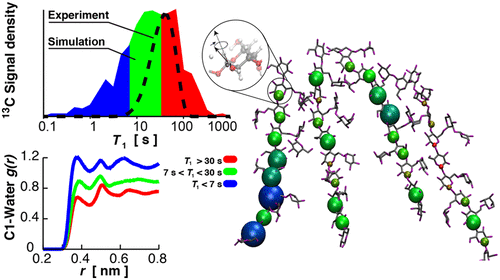当前位置:
X-MOL 学术
›
Biomacromolecules
›
论文详情
Our official English website, www.x-mol.net, welcomes your feedback! (Note: you will need to create a separate account there.)
Hydration-Dependent Dynamical Modes in Xyloglucan from Molecular Dynamics Simulation of 13C NMR Relaxation Times and Their Distributions
Biomacromolecules ( IF 6.2 ) Pub Date : 2018-04-24 00:00:00 , DOI: 10.1021/acs.biomac.8b00191 Pan Chen 1 , Camilla Terenzi 1 , István Furó 1 , Lars A. Berglund 1 , Jakob Wohlert 1
Biomacromolecules ( IF 6.2 ) Pub Date : 2018-04-24 00:00:00 , DOI: 10.1021/acs.biomac.8b00191 Pan Chen 1 , Camilla Terenzi 1 , István Furó 1 , Lars A. Berglund 1 , Jakob Wohlert 1
Affiliation

|
Macromolecular dynamics in biological systems, which play a crucial role for biomolecular function and activity at ambient temperature, depend strongly on moisture content. Yet, a generally accepted quantitative model of hydration-dependent phenomena based on local relaxation and diffusive dynamics of both polymer and its adsorbed water is still missing. In this work, atomistic-scale spatial distributions of motional modes are calculated using molecular dynamics simulations of hydrated xyloglucan (XG). These are shown to reproduce experimental hydration-dependent 13C NMR longitudinal relaxation times (T1) at room temperature, and relevant features of their broad distributions, which are indicative of locally heterogeneous polymer reorientational dynamics. At low hydration, the self-diffusion behavior of water shows that water molecules are confined to particular locations in the randomly aggregated XG network while the average polymer segmental mobility remains low. Upon increasing water content, the hydration network becomes mobile and fully accessible for individual water molecules, and the motion of hydrated XG segments becomes faster. Yet, the polymer network retains a heterogeneous gel-like structure even at the highest level of hydration. We show that the observed distribution of relaxations times arises from the spatial heterogeneity of chain mobility that in turn is a result of heterogeneous distribution of water–chain and chain–chain interactions. Our findings contribute to the picture of hydration-dependent dynamics in other macromolecules such as proteins, DNA, and synthetic polymers, and hold important implications for the mechanical properties of polysaccharide matrixes in plants and plant-based materials.
中文翻译:

从13 C NMR弛豫时间及其分布的分子动力学模拟中,木葡聚糖的水合作用动力学模式
生物系统中的大分子动力学在环境温度下对生物分子的功能和活性起着至关重要的作用,在很大程度上取决于水分含量。然而,仍然缺乏基于聚合物及其吸附的水的局部松弛和扩散动力学的水合依赖性现象的定量模型。在这项工作中,使用水合木葡聚糖(XG)的分子动力学模拟来计算运动模式的原子尺度空间分布。这些被证明可重现与水合作用相关的13 C NMR纵向弛豫时间(T 1)及其在室温下的广泛分布的相关特征,这些都表明了局部异质聚合物的重新定向动力学。在低水合作用下,水的自扩散行为表明水分子被限制在随机聚集的XG网络中的特定位置,而平均聚合物链段迁移率仍然很低。随着水含量的增加,水合网络变得可移动,并且对于单个水分子而言完全可访问,并且水合XG链段的运动变得更快。然而,即使在最高水合水平下,聚合物网络仍保留非均相的凝胶状结构。我们表明,观察到的弛豫时间分布是由于链运动的空间异质性引起的,而空间异质性又是水链和链链相互作用的异质分布的结果。我们的发现有助于了解其他大分子(如蛋白质,DNA和合成聚合物)中水合作用的动力学,并对植物和植物基材料中多糖基质的机械性能具有重要意义。
更新日期:2018-04-24
中文翻译:

从13 C NMR弛豫时间及其分布的分子动力学模拟中,木葡聚糖的水合作用动力学模式
生物系统中的大分子动力学在环境温度下对生物分子的功能和活性起着至关重要的作用,在很大程度上取决于水分含量。然而,仍然缺乏基于聚合物及其吸附的水的局部松弛和扩散动力学的水合依赖性现象的定量模型。在这项工作中,使用水合木葡聚糖(XG)的分子动力学模拟来计算运动模式的原子尺度空间分布。这些被证明可重现与水合作用相关的13 C NMR纵向弛豫时间(T 1)及其在室温下的广泛分布的相关特征,这些都表明了局部异质聚合物的重新定向动力学。在低水合作用下,水的自扩散行为表明水分子被限制在随机聚集的XG网络中的特定位置,而平均聚合物链段迁移率仍然很低。随着水含量的增加,水合网络变得可移动,并且对于单个水分子而言完全可访问,并且水合XG链段的运动变得更快。然而,即使在最高水合水平下,聚合物网络仍保留非均相的凝胶状结构。我们表明,观察到的弛豫时间分布是由于链运动的空间异质性引起的,而空间异质性又是水链和链链相互作用的异质分布的结果。我们的发现有助于了解其他大分子(如蛋白质,DNA和合成聚合物)中水合作用的动力学,并对植物和植物基材料中多糖基质的机械性能具有重要意义。



























 京公网安备 11010802027423号
京公网安备 11010802027423号